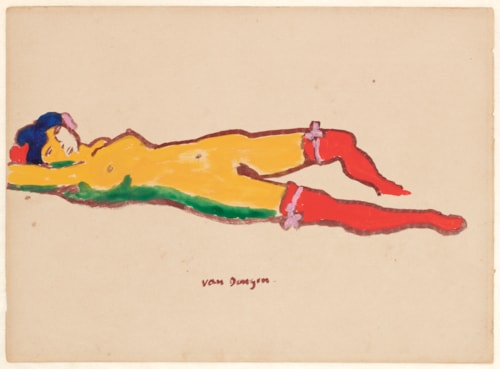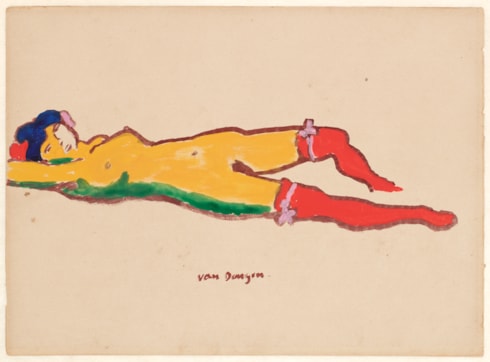
Kees VAN DONGEN
Delfshaven 1877 - Monte Carlo 1968
Biography
Born near Rotterdam, Cornelis Theodorus Marie van Dongen, known as Kees, studied at the Akademie voor Beeldende Kunsten in the city, where he enjoyed a reputation as a gifted draughtsman. He often roamed the streets of the port and the Red Quarter where he made drawings of sailors and prostitutes; this interest in the lower classes of society was to be characteristic of his work for much of the first two decades of his career. (Almost all of the artist’s earliest drawings, however, seem to have been later destroyed.) After a stay of several months in Paris in 1897, at the age of twenty, Van Dongen settled for good in the French capital in 1899, living in the Butte Montmartre. He worked mainly as an illustrator and lithographer for a number of magazines and newspapers, notably La Revue Blanche and L’Assiette au Beurre, and met the well-known art critic and editor Félix Fénéon. As a painter, he first exhibited at the Salon des Indépendants and at the Salon d’Automne in 1904, without much success. In November of that year, however, he was given an exhibition at the Parisian gallery of Ambroise Vollard, with more than a hundred works on view and a catalogue prefaced by Fénéon. This exhibition brought his name to a much wider public, and effectively launched his career as a painter and draughtsman.
Van Dongen moved into a studio at the Bateau-Lavoir in Montmartre, where he befriended Pablo Picasso and his lover Fernande Olivier, who became one of his favourite models and posed for him several times. In 1905 he exhibited two paintings at the Salon d’Automne, where his work was shown near that of Henri Matisse, André Derain, Albert Marquet and Maurice de Vlaminck. Their boldly coloured canvases led the critic Louis Vauxcelles to label them as ‘Fauves’, or ‘wild beasts’, and Van Dongen became associated with the group, exhibiting with them over the next few years. His style became more radical in tonality, with a Fauvist use of pure, flat colour, and a powerful chromatic intensity, and his choice of subject matter was often provocative. His paintings and drawings of female nudes, in particular, were considered scandalous, and sometimes obscene, even by the standards of a sophisticated Paris. On the occasion of an exhibition of his work at the newly-opened gallery of Daniel-Henry Kahnweiler in Paris in 1908, Vauxcelles opined that ‘Kees Van Dongen is one of our most daring among the young exhibitors of the ‘Indépendents’. But his talent, personal, unequal, incomplete, undeniable, gives him an enviable place.’ Through Kahnweiler, who championed the artist’s work in Germany, Van Dongen met the Expressionist painter Max Pechstein, and was invited to exhibit with the Die Brücke group in Germany in 1908.
From 1910 Van Dongen began selling his paintings through the prestigious Bernheim-Jeune gallery, where he had first shown in 1908, and gained a measure of commercial success that allowed him to make several trips to Italy, Spain, Morocco and Egypt. After the First World War, he developed a reputation as a fashionable society portrait painter, and in 1922 he stopped working with dealers and instead organized selling exhibitions in his studio. He became a naturalized French citizen in 1929, and exhibited his work throughout Europe. Although he was highly successful, and much in demand, his later work does not reach the artistic heights of his pre-war paintings. His work nevertheless provides a fascinating visual record of fashion and social life in Paris in the first half of the 20th century, and earned him numerous awards over the course of his long career. In 1959 Van Dongen moved to Monaco, where he died in 1968, the year after a large retrospective exhibition of his entire oeuvre was held in Rotterdam and Paris.


